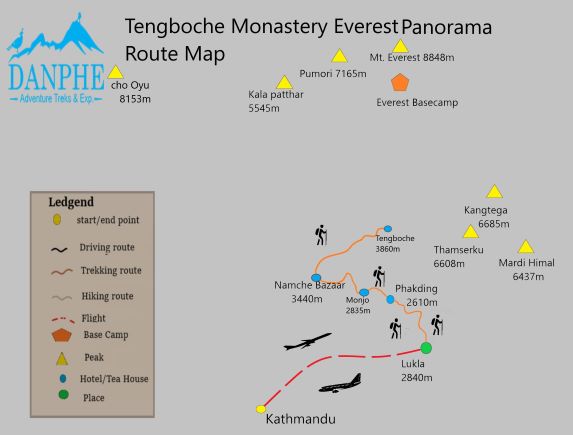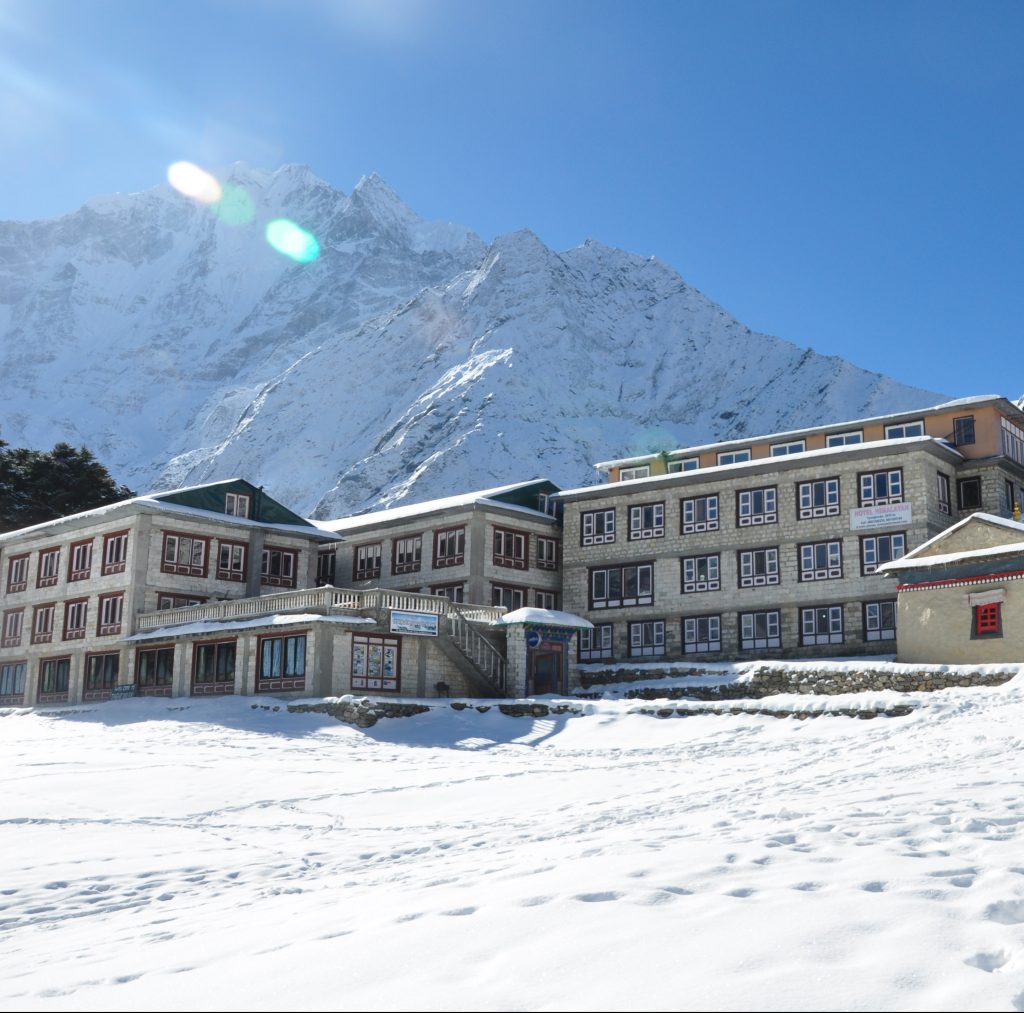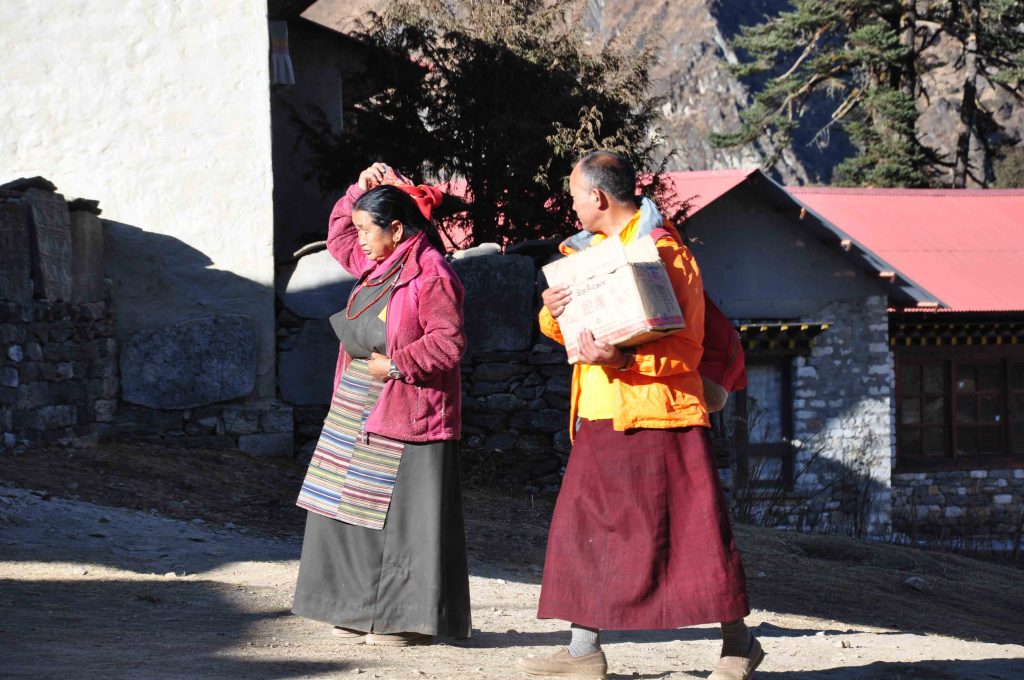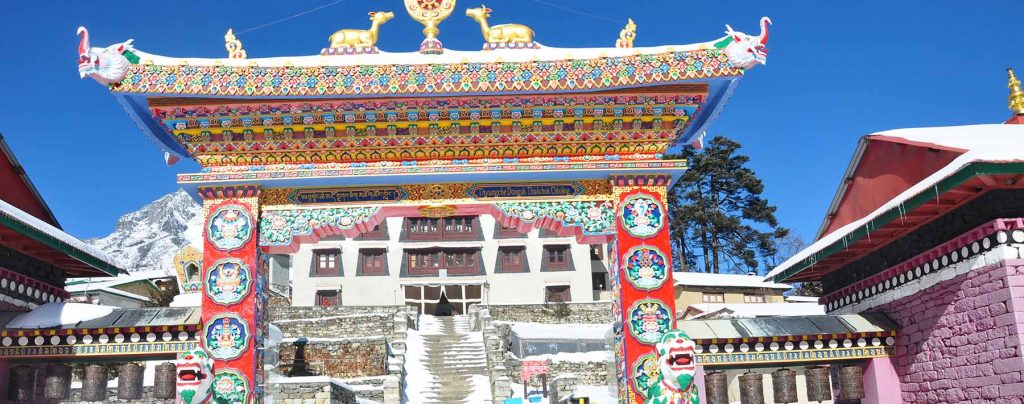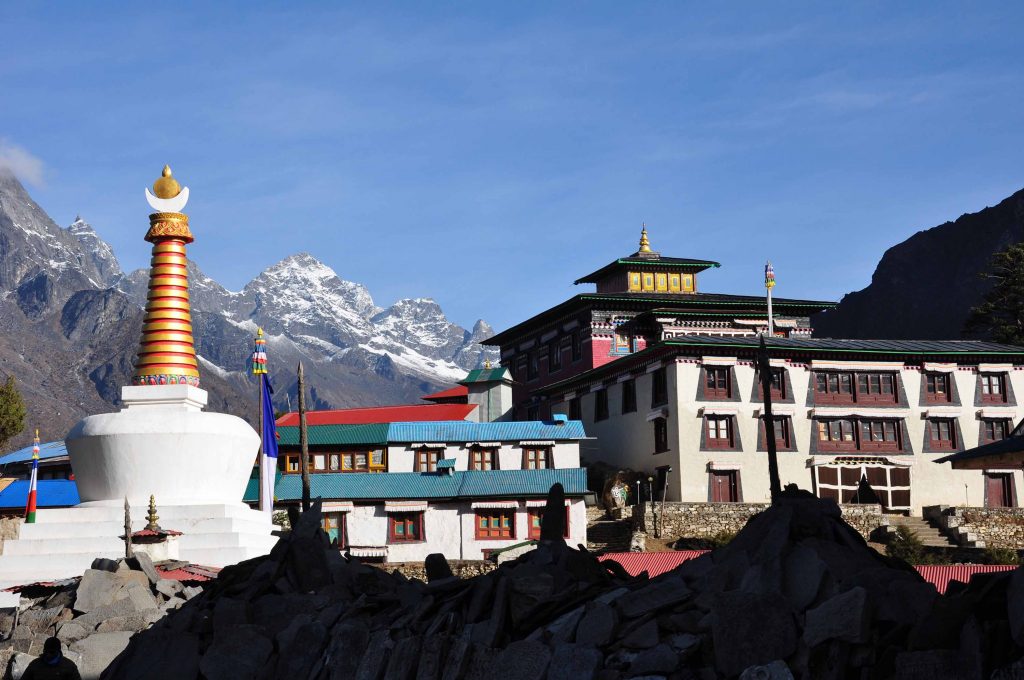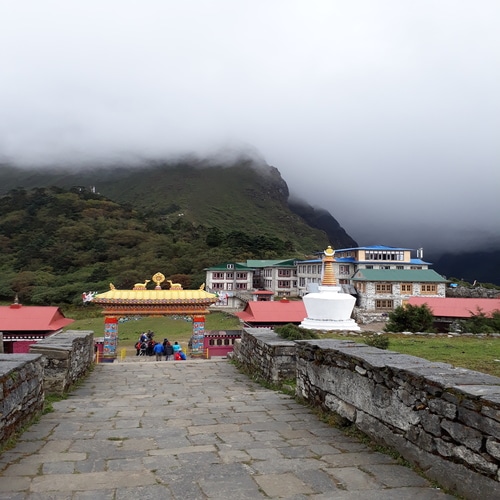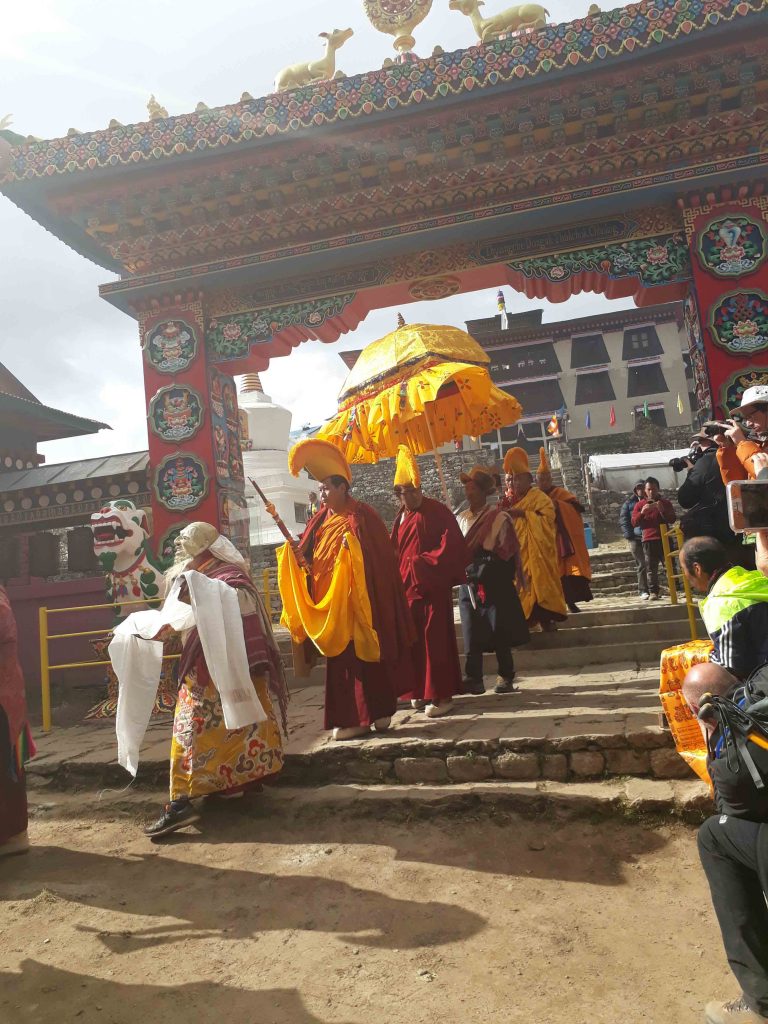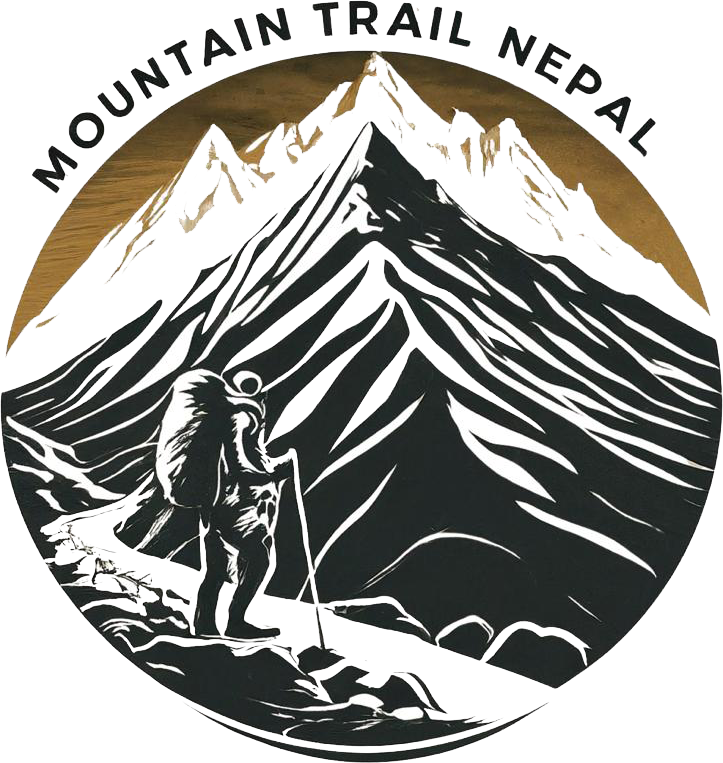Trip Highlights
- Experience the captivating ambiance of Sagarmatha National Park.
- Marvel at the breathtaking Himalayan panorama, including Mount Everest (8848m), from Tengboche Monastery.
- Enjoy the warm hospitality and rich culture of the Sherpa community during the trek.
- Discover the UNESCO World Heritage sites in the Kathmandu Valley.
Trip Itinerary
Expand All
Shrink All
-
Day 01: Arrival in Kathmandu (1,300m)
Hello fellow trekkers! When you arrive at Tribhuvan International Airport, our team will be there to greet you. We’ll then take a short drive to the hotel. Once you’ve checked in and freshened up, our guide will give you a briefing about the trip and help with any final preparations. You’ll spend the night at a hotel in Kathmandu.
-
Day 02: Kathmandu Sightseeing and Trek Preparation
Today, we’ll explore the UNESCO World Heritage sites in the Kathmandu Valley. We’ll visit Kathmandu Durbar Square, Boudhanath Stupa, Swayambhunath Temple, and the Pashupatinath Temple. These places are filled with art, culture, and history, showcasing the rich heritage of the Kathmandu Valley. After our sightseeing tour, you can prepare for the trek and get ready for the adventure ahead. You’ll spend the night at a hotel in Kathmandu.
-
Day 03: Fly from Kathmandu to Lukla (2,840m) and trek to Phakding (2,610m)
We wake up early and catch a 35-minute flight to Lukla, enjoying stunning views of the Himalayas in the Everest region from the plane. Once we land in Lukla, our trek begins towards Phakding. The trail takes us through several villages and ancient monasteries along the Dudh Koshi River. We’ll spend the night in Phakding.
-
Day 04: Trek from Phakding (2,610m) to Namche Bazaar (3,440m)
From Phakding, we trek to Monjo, which is north of Phakding and serves as the entrance to Sagarmatha National Park. The trail passes through the park, reaching Jorsalle and eventually Namche. Along the way, we’ll experience the beauty of Sagarmatha National Park, with its alpine forests, streams, small rivers, and lush jungles. We’ll spend the night in Namche Bazaar.
-
Day 05: Rest day at Namche Bazaar (3,440m) for acclimatization
Namche is a wonderful place to enjoy nature. The views here are stunning and captivating. You can visit the Syangboche Airstrip for a panoramic view of Namche and the Himalayas. A bit further from Namche is the Everest View Hotel, which is the highest hotel and offers amazing views of Mount Everest and other peaks.
In Namche itself, you can explore the Everest Photo Gallery and the Sherpa Culture Museum. We’ll spend the night in Namche Bazaar.
-
Day 06: Trek from Namche Bazaar (3,440m) to Tengboche (3,860m) | Everest Panorama View
We continue our trek alongside the Dudh Koshi River until we reach Kyangjuma. From there, we descend to the river and cross a bridge to Phunki Tenga. Then, the trail gets a bit tougher as we hike for about two and a half hours to reach Tengboche.
At Tengboche, we explore the Tengboche Monastery, which is very important to the Sherpas. It offers a beautiful view of Mount Everest, Makalu, Lhotse, and Thamserku. We’ll spend the night in Tengboche.
-
Day 07: Trek from Tengboche to Monjo (2,835m)
Today, we go back the way we came, passing through Namche Bazaar on our way to Monjo. We’ll enjoy the beautiful mountain views along the journey. Sometimes, we’ll encounter other trekkers and mules on the trail. Eventually, we’ll arrive in Monjo, which is the entrance to Sagarmatha National Park. We’ll spend the night in Monjo.
-
Day 08: Trek from Monjo to Lukla (2,840m)
Today is the final day of our trek, and it’s a short one, lasting around 4-5 hours. We’ll follow the Dudh Koshi River, walking mostly uphill and downhill, until we reach Lukla. Along the way, we’ll pass through countryside and villages like Phakding and Ghat. We’ll spend the night in Lukla.
-
Day 09: Fly back to Kathmandu (1,300m)
As we fly back to Kathmandu, we’ll soak in the breathtaking views of the Himalayas from the airplane. Once we land in Kathmandu, you have the rest of the day to relax at the hotel or explore the city, which is influenced by the Newar culture. There are plenty of places to visit in the city, so feel free to choose what interests you. We’ll spend the night at a hotel in Kathmandu.
-
Day 10: Spare Day (In case of Bad weather) and Farewell dinner
Today is a free day just in case our flight from Lukla gets delayed or canceled due to bad weather, which can happen sometimes. This is beyond our control, so it’s good to have a backup plan. In the evening, we’ll have a farewell dinner to celebrate the success of our trek. We’ll spend the night at a hotel in Kathmandu.
-
What's Included
- Private airport transfers in a comfortable vehicle for arrival and departure.
- Accommodation in Kathmandu with breakfast included, as per the itinerary.
- Guided cultural tour of Kathmandu with a knowledgeable guide and private vehicle.
- All meals (Breakfast, Lunch, and Dinner) provided during the trek.
- Comprehensive ground and air transportation arrangements throughout the trek.
- Experienced, English-speaking guide and porter ratio of 1 porter for every 2 trekkers.
- Staff salaries covering their food, accommodation, and transportation expenses.
- Arrangement of all necessary permits, including Conservation entry permits and TIMS card.
- Emergency helicopter service arrangement, covered by your travel insurance.
- Provision of essential trekking equipment, including sleeping bag, down jacket, and trekking map (to be returned after the trek).
- Inclusive of all government taxes, VAT, and local taxes for a hassle-free experience.
- Nepal entry visa fee ($25 USD), obtainable upon arrival at Tribhuwan International Airport in Kathmandu. Please prepare 2 passport size photos.
- International airfare to and from Kathmandu.
- Compulsory travel insurance covering the duration of your trip.
- Meals in Kathmandu, giving you the flexibility to explore local dining options.
- Entry fees for cultural tours and attractions during your stay in Kathmandu.
- Personal expenses such as alcoholic and non-alcoholic beverages, bar bills, battery charges, additional porter services, and hot water showers.
- Tips for your guide, porter, and driver, which are discretionary but highly appreciated for their excellent service
Equipment List
List of Equipments required for Tengboche Monastery Trek:
Head:
- Warm winter hat/beanie
- Sun hat
- Headband/buff
- Sunglasses with UV protection
- Headlamp/Torch with extra batteries
Upper Body:
- Light fleece sweater
- Heavy fleece sweater
- Quick-drying long-sleeved base layer shirts (2 pairs)
- Short sleeve trekking shirts (3 pairs)
- Wind/rainproof jacket
- Down jacket
Lower Body:
- Trekking shorts
- Trekking trousers
- Lightweight thermal bottoms (seasonal)
- Trekking pants with zip-off bottoms (2 pairs)
- Fleece or woolen trousers
- Waterproof pants
Hands:
- Lightweight warm gloves
- Poly-liner gloves
Feet:
- Trekking boots
- Sandals/trainers (for wearing around the lodges)
- Down booties
- Thin lightweight inner socks (2 pairs)
- Warm woolen or poly socks (2 pairs)
- Gaiters (only in winter)
Other:
- Sleeping bag
- Sleeping bag liner (optional)
- Trekking poles (1 pair)
- Water purification tablets/Steripen/drops
- Quick-drying towel
Feel free to adjust this list based on your personal preferences and the specific requirements of your trek. It’s essential to ensure you have the necessary gear to stay comfortable and safe during your adventure in the Nepalese mountains.
FAQs
-
What are the visa requirements?
Currently, all the foreign nationalities (except Indians) require a visa to enter Nepal. Visas are obtainable from embassies abroad or on arrival at Kathmandu’s Airport. If getting the visa at the airport be prepared for long queues. You will also need to provide one passport photo and the $50 USD fee for 30 days.
-
What are the physical requirements for Tengboche Monastery with Everest Panorama Trek?
Tengboche Monastery with Everest Panorama Trek requires you to trek at an altitude of a maximum of 3860m and up to 5- 8 hours per day, with a small 5-7kg bag. We recommended you to train with long hikes and/or a sport of your choice (e.g. jogging).
-
How old do I need to be?
There is no age restriction for doing this trip, but if you are under 16 it will better to trek with your parents. You must be health-conscious during the trek.
-
What is included?
Included:
- Guides and Porters
- Transportation (including airport transfers)
- Accommodation
- Permits & national park fees
- Sightseeing tour in Kathmandu
- All meal during the trek
- Seasonal fruits
Excluded:
- International flights to Kathmandu
- Food – (while you are in City)
- Showers on Trek
- Tips
- Visa fees (typically $50 USD)
- Personal travel/rescue insurance
-
Can I use a helicopter if I need to?
To be sure that you make your trek, or return from it, it may be necessary to make the flight to/from Lukla by a chartered helicopter. Helicopters can operate in some weather that aircraft cannot. Should a helicopter be needed, it will be at the expense of the travelers. Please seek further advice about this from your insurance provider.
Hopefully, weather delays will not occur, or if they do it will be for a limited time. Should the delays stretch into days and neither helicopter nor flight are a viable option, a collective decision will be made by the group on how to proceed.
-
What is the accommodation like?
You will stay in the Hotel while you are in the city of Kathmandu, which is like a 3-star category. The hotel has access to showers and intermittent internet.
But while you are in trekking Tea House/lodges are the place where you spend the night during the trek, which is very basic. The room is pretty small with twin sharing and a common washroom. Some places have squat style toilets, whilst others have a western style. Shower does not always offer warm water and most teahouses will charge you for use of a hot shower.
-
Which meals are included?
Meals will be served as per the menu of the teahouse/lodges. Where you can find a variety of dishes like Indian, Nepalese, Tibetan, Continental, etc, to choose. Tea, coffee, bakery items, snacks, bars eggs, etc can also be found easily.
-
What currency should I take?
The currency used in Nepal is Nepalese Rupees (NPR). You are unable to get NPR outside of Nepal and therefore you will need to exchange money in Kathmandu. The easiest currency to exchange is USD and Euro. You can also withdraw NPR from the ATM but check with your bank about the relevant charges to do this.
-
Is there any Bank or ATM facility during Tengboche Monastery Everest Panorama Trek?
Yes, there is a good facility of bank and ATM in Lukla and Namche Bazaar.
-
What kind of problems can arise at a higher altitude during Tengboche monastery with Everest panorama Trek?
There is a huge change of AMS problem i.e. Acute Mountain Sickness problem. It may cause some problems as you trek higher above 3500-meter altitude (11,482 ft.). But don’t worry about that. We have carefully designed our Tengboche monastery with Everest panorama trek itinerary with sufficient time for acclimatization and less walking time each day. And our experienced trek guide will be helping you with it.
-
Do I need insurance before the Tengboche Monastery with Everest panorama Trek?
Yes, you need to be insured before the adventure trekking in Nepal from your home country. However, we will be always with you taking care of throughout the whole Tengboche Monastery with Everest panorama trek.
-
What should I pack?
Documents
- Passport
- Travel insurance details
- 2 passport photos
- Cash USD
- Credit/Debit Card
Head
One Warm winter hat/beanie.
One Sun hat
1 Headband/buff.
1 Sunglasses with UV protection.
One Headlamp/ Torch with extra batteries.
Upper Body
2 pairs of Fleece sweaters- one light and one heavier
2 pairs of quick-drying long-sleeved base layer shirts
3 pairs of Short sleeve trekking shirts
1 pair of Wind/rainproof Jacket v 1 Down Jacket
Lower Body
One pair of trekking shorts
A pair of trekking trousers
One pair of lightweight thermal bottoms (seasonal)
Two pairs of trekking pants with Ziff off bottoms
One pair of fleece or woolen trousers
Two pair of waterproof pants, breathable fabric
Hands
A pair of lightweight warm gloves
A pair of poly-liner glove
Feet
One pair of trekking boots
A pair of sandals/ trainers (for wearing around the lodges)
One pair of down booties (great for keeping feet warm)
Two pair of thin lightweight inner socks
Two pair of warm woolen or poly socks
Gaiters (only in winter)
Other
One Sleeping Bag
One Sleeping bag liner (optional)
A pair of trekking poles
Water purification tablets/Steripen/Drops
One quick-drying towel
-
What is the best time of year for Tengboche Monastery Everest Panorama Trek?
